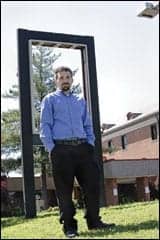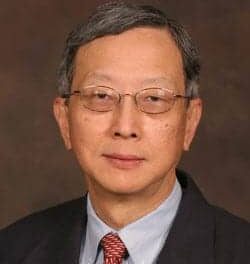By embracing a unique opportunity with a hands-on approach, the LLUMC biomeds made their wish list come true
 Larry Feenstra, director of clinical engineering (CE) at the Loma Linda University Medical Center (LLUMC), admits that 3 years ago, when he was informed that his department and its 17-member staff would have to move from its aging facility to make room for an expanding school of pharmacy, he was hardly enthusiastic about the prospect. Housed since 1971 in a ward of the former nursing school, the CE facility was anything but ideal. For one thing, the catch-as-catch-can floor plan included a large hallway through its center. The rest of the space? A labyrinth of former patients’ rooms. Buried on the first floor of a downsloping property, most of the facility was windowless and dark.
Larry Feenstra, director of clinical engineering (CE) at the Loma Linda University Medical Center (LLUMC), admits that 3 years ago, when he was informed that his department and its 17-member staff would have to move from its aging facility to make room for an expanding school of pharmacy, he was hardly enthusiastic about the prospect. Housed since 1971 in a ward of the former nursing school, the CE facility was anything but ideal. For one thing, the catch-as-catch-can floor plan included a large hallway through its center. The rest of the space? A labyrinth of former patients’ rooms. Buried on the first floor of a downsloping property, most of the facility was windowless and dark.
In retrospect, he quips, the only good thing about it was that, “The doors to the rooms were 4 feet wide.”
Today, his department’s new home—renovated extensively from an adjacent one-story building—has 5,500 square feet of primary facilities, plus an additional 1,200 square feet reserved for receiving and storage. It boasts 12 custom-designed technician workbenches; separate office and logistics areas, the latter for parts storage, and incoming equipment repair; the latest in electrical, medical gas, lighting, information technology (IT), and A/V utilities with built-in room for further expansion; extra space in the machine shop for fabrication and research and development, such as working to develop custom brackets and mounts for medical equipment; and lots and lots of windows. And where windows are not possible, for example in the break room and library, Solartube skylights have been installed.
“It’s important to have as much natural light as possible,” Feenstra says. “Natural lighting adds to energy conservation and is vital if the power were to go out.” That is not a bad point in light of the rolling brownouts this part of the country experienced only a few years ago because of an electricity shortage. Still, you get the sneaking suspicion that Feenstra likes his natural lighting, all other things being equal. Having the facility fit his needs and predilections, was the biggest advantage that Feenstra and his staff discovered when, after a slow start out of the gate, they embraced with gusto the prospect of a new facility. Taking a hands-on approach, they worked directly with the architect and contractor, even interviewing and hiring some of the craftsmen themselves.
As Josias Robinson, a BMET1 on Feenstra’s staff, recently summed up, “The design, building remodel, and relocation of the CE department here at LLUMC have been beneficial in many ways. Improvements in personal safety and working conditions, as well as employee morale, are most significant.”
Go East, Young Men and Women
The expansion of Loma Linda’s CE department could not have come at a better time. Not only has the medical center itself grown dramatically since it first opened in 1968—nearly 900 beds are available now for patient care—its staff also serves a wide swath of the region east of Los Angeles known as the Inland Empire.
For the 4 decades following World War 2, the Riverside and San Bernardino counties of Southern California were largely sleepy, working-class bedroom communities for the Los Angeles metropolis. However, since the 1990s, the area has emerged as an economic powerhouse in its own right. The region’s median income now surpasses that of Los Angeles County, and it is generating more jobs than Orange and San Diego counties combined.
LLUMC is the largest medical facility in the fast-growing region, each year admitting more than 33,000 inpatients and serving about a half-million outpatients. As the only tertiary care hospital in the area, the institution is the only Level 1 regional trauma center for Riverside and San Bernardino counties, as well as the adjoining counties of Inyo and Mono.
For the CE department, that means servicing all of the facilities at LLUMC as well as 20 university clinics spread out in a 60-mile radius from the main campus. It also services Veterans Affairs medical clinics as far south as the Temecula Valley near the border of San Diego County and as far east as Palm Desert.
Once Feenstra and his staff realized that the relocation of their department presented a unique opportunity, they moved quickly to draw up a list of what they did not like about the old space and what they wanted in a new one.
On their list of problems with the previous facility:
• Inefficient design;
• Most of the area chopped up in smaller rooms;
• Crowded with equipment and furnishings; and
• Difficult and not safe to walk through.
The goals of the new facility included:
• Reduced trip/fall and other personal safety hazards;
• Improved working conditions;
• Improved employee morale;
• Improved workflow and efficiency; and
• Improved access for pickup and delivery, with direct deliveries received at the new street address rather than having to go through the medical center’s shipping/receiving department.
No Taj Mahal
All that said, Feenstra stresses that the new facility was created on a tight budget. The parent organization for LLUMC is a foundation established by the Seventh-day Adventist Church, which by definition is a nonprofit and not one inclined to look kindly on profligate expenditures. “None of it was given to us carte blanche. Management was not going to build us a Taj Mahal. We had to show the direct benefits of all the costs,” he says.
Cost-saving strategies began from the ground up. To begin with, the new facility was not new, but rather a building remodel—a family-owned mortuary, to be exact. While it was better in overall design than the old nursing-school ward where the department had been housed, the building was not without its own set of structural problems. “There was this block wall running diagonally through the length of the space. That had to go. We needed to have this big, open space,” Feenstra says. It also had a number of small rooms that did not fit into the new concept.
His staff rose to the challenge. Immersing themselves in building design, they worked directly with the architect to figure out how new vertical supports, positioned between the technicians’ workbenches, could take the place of the diagonal wall.
But they did not stop there. Recognizing that the technician workbenches are where they would spend, on average, the better part of their workday, Feenstra and company began researching what was available prefabricated. “What we discovered was we couldn’t afford the prefab benches on our budget, and even if we could, they didn’t fit into our new floor plans,” he says. There was only one way to go: custom built. But again, rather than relying on the contractor to find a subcontractor, Feenstra and his team interviewed their own cabinetmakers. “The workbenches were going to mean a lot to us, so we wanted them done right.”
Indeed, a whole section of the floor-plan design was devoted to describing the ideal workbench. The technician work area was designed as the heart of the floor plan, with access to service areas and documentation, improved communication between office staff and technicians, and equipment flow as the main considerations, according to Robinson. “The technician work spaces were to be enhanced with generous electrical services; excellent lighting; A/V; IT services, including updated computers; medical gasses; and adequate space and storage requirements, depending on the types of equipment generally serviced by each technician,” he says.
In the end, they got everything they wanted by handpicking a cabinetmaker who was not only highly skilled and experienced but flexible enough to work with them and listen to their ideas. The facility’s 12 technicians’ workbenches, as well as two more for IT and shipping/receiving, were built in only 3 months from initial drawings to final product. Here’s the best part: While the off-the-shelf product that came closest to what they wanted in a workbench would have cost $6,000 each, they got three custom-made workbenches for the same price, and then some.
Making the Most of IT
Feenstra’s staff also oversees the maintenance of all IT equipment for the LLUMC facilities, which is unusual for a biomed or CE department. That’s everything from your basic ink jet printer to sophisticated hardware that stores and processes the center’s medical records. In fact, his technicians are actually authorized by the manufacturers to do their own under-warranty repairs. Two of Feenstra’s technicians are dedicated to IT hardware repairs and maintenance.
Why IT? Simple. “It’s a matter of time,” Feenstra says. “By doing our own repairs, we cut our equipment downtime substantially. While in the past, IT training of his staff was done off-site, today, thanks to the Internet, much of it is done online—still another time-saver.
Among the more exotic of the myriad medical equipment his team maintains are the da Vinci brand robotic instruments for minimally invasive surgery. The $1 million machines allow surgeons to make precise incisions and even suture through very small ports in the skin.
Also on the checklist of “not your average equipment” are sophisticated neonatal incubators that his department services. LLUMC has one of the largest neonatal care clinical programs in the United States, and it is recognized as a leader in infant heart-transplant surgery. “We have a current project to reduce the weight and size of our transport infant incubators, which also requires quite a bit of time in the machine shop as new lighter-battery and medical-gas cylinder technologies are being implemented,” Feenstra says.
Along with getting a new facility, Feenstra also made the case that it was time to retire the department’s rattletrap cargo van and exchange it for a new Sprinter, 5-cylinder diesel van, which is tall enough to stand in and comes complete with a rear automatic lift. The new truck is ideal for transporting the incubators.
Still More To Come
The new facility was dedicated on December 16, 2004. As Feenstra and his staff mark nearly 2 years there, he says, “I think we’re all pleased with it.” However, he already has started another wish list. High on the list is a backup generator dedicated to his department (six portable generators are available for triage facilities on campus).
Interestingly, a fire-sprinkler system is not on the list. “With all of the equipment we have here, it’s probably not a good idea to have it accidentally doused in water,” he says. Instead, there are equipment-appropriate fire extinguishers located throughout the facility. However, with a nod to fire safety, the facility’s brand-new 800-amp transformer is located 100 feet away from the building.
There is one more thing for which he hopes to secure funding: a remote computer system that his technicians can use in the field. “If all goes well, all of the staff will one day soon be interconnected with a Wi-Fi PDA internal network. They would allow us to update inventory and maintenance records in real time,” he says.
Greg Ptacek is a contributing writer for 24×7.




